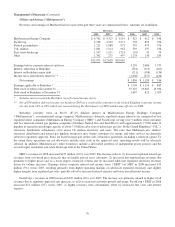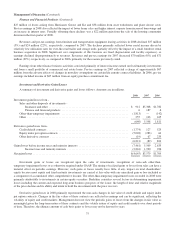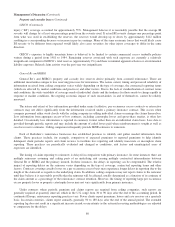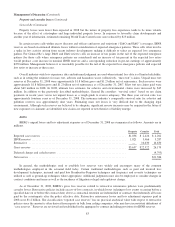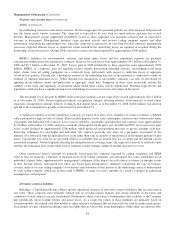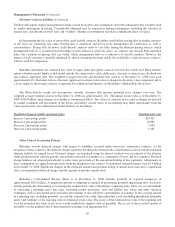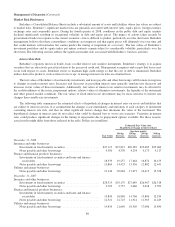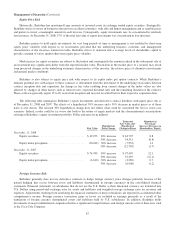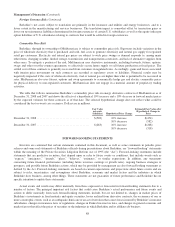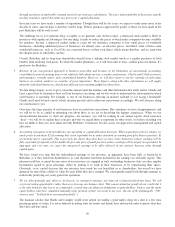Berkshire Hathaway 2008 Annual Report Download - page 82
Download and view the complete annual report
Please find page 82 of the 2008 Berkshire Hathaway annual report below. You can navigate through the pages in the report by either clicking on the pages listed below, or by using the keyword search tool below to find specific information within the annual report.Management’s Discussion (Continued)
Property and casualty losses (Continued)
GEICO (Continued)
injury (“BI”) coverage accounted for approximately 55%. Management believes it is reasonably possible that the average BI
severity will change by at least one percentage point from the severity used. If actual BI severity changes one percentage point
from what was used in establishing the reserves, the reserves would develop up or down by approximately $112 million
resulting in a corresponding decrease or increase in pre-tax earnings. Many of the same economic forces that would likely cause
BI severity to be different from expected would likely also cause severities for other injury coverages to differ in the same
direction.
GEICO’s exposure to highly uncertain losses is believed to be limited to certain commercial excess umbrella policies
written during a period from 1981 to 1984. Remaining reserves associated with such exposure are currently a relatively
insignificant component of GEICO’s total reserves (approximately 2%) and there is minimal apparent asbestos or environmental
liability exposure. Related claim activity over the past year was insignificant.
General Re and BHRG
General Re’s and BHRG’s property and casualty loss reserves derive primarily from assumed reinsurance. There are
additional uncertainties unique to loss reserving processes for reinsurance. The nature, extent, timing and perceived reliability of
information received from ceding companies varies widely depending on the type of coverage, the contractual reporting terms
(which are affected by market conditions and practices) and other factors. Due to the lack of standardization of contract terms
and conditions, the wide variability of coverage needs of individual clients and the tendency for those needs to change rapidly in
response to market conditions, the ongoing economic impact of such uncertainties, in and of themselves, cannot be reliably
measured.
The nature and extent of loss information provided under many facultative, per occurrence excess contracts or retroactive
contracts may not differ significantly from the information received under a primary insurance contract. This occurs when
company personnel either work closely with the ceding company in settling individual claims or manage the claims themselves.
Loss information from aggregate excess-of-loss contracts, including catastrophe losses and quota-share treaties, is often less
detailed. Occasionally loss information is reported in summary format rather than on an individual claim basis. Loss data is
provided through periodic reports and may include the amount of ceded losses paid where reimbursement is sought as well as
case loss reserve estimates. Ceding companies infrequently provide IBNR estimates to reinsurers.
Each of Berkshire’s reinsurance businesses has established practices to identify and gather needed information from
clients. These practices include, for example, comparison of expected premiums to reported premiums to help identify
delinquent client periodic reports and claim reviews to facilitate loss reporting and identify inaccurate or incomplete claim
reporting. These practices are periodically evaluated and changed as conditions, risk factors and unanticipated areas of
exposures are identified.
The timing of claim reporting to reinsurers is delayed in comparison with primary insurance. In some instances there are
multiple reinsurers assuming and ceding parts of an underlying risk causing multiple contractual intermediaries between
General Re or BHRG and the primary insured. In these instances, the delays in reporting can be compounded. The relative
impact of reporting delays on the reinsurer varies depending on the type of coverage, contractual reporting terms and other
factors. Contracts covering casualty losses on a per occurrence excess basis may experience longer delays in reporting due to the
length of the claim-tail as regards to the underlying claim. In addition, ceding companies may not report claims to the reinsurer
until they believe it is reasonably possible that the reinsurer will be affected, usually determined as a function of its estimate of
the claim amount as a percentage of the reinsurance contract retention. However, the timing of reporting large per occurrence
excess property losses or property catastrophe losses may not vary significantly from primary insurance.
Under contracts where periodic premium and claims reports are required from ceding companies, such reports are
generally required at quarterly intervals which in the U.S. range from 30 to 90 days after the end of the accounting period. In
continental Europe, reinsurance reporting practices vary. Fewer clients report premiums, losses and case reserves on a quarterly
basis. In certain countries, clients report annually, generally 90 to 180 days after the end of the annual period. The extended
reporting lag does not result in a significant increase in risk or uncertainty as the actuarial reserving methodologies are adjusted
to compensate for the delays.
80


